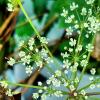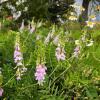Pueraria Mirifica or White Kwao Krua (also traditionally called Kudzu) is an herbal plant that has long been used in Thailand and Southeast Asia for medicinal history and beauty enhancement purposes. These plants are found mostly in the highlands.
Although there have been reports of finding similar plants in the same family, "Pueraria," in other Asian countries, these plants are of different species. They do not possess the same qualities as the Pueraria Mirifica cultivated in Thailand. Nevertheless, women in the rural Thai villages have used the tuberous roots of Kwao Krua effectively as rejuvenating, breast enlarging, and youth maintaining folk medicine for well over a century.
A natural skin improvement can be rapidly noticed with the Kudzu, a plant full of phytoestrogens that will stimulate hormonal and cellular activity. Likewise, Pueraria Mirifica extract helps to promote the development of mammary tissues to give you a fuller and firmer bust-line. It does this by introducing naturally occurring plant estrogens to the estrogen receptor sites in the breasts.
Pueraria Mirifica root extract can also help rehydrate the skin and strengthen collagen and elastin, giving a firmer bust. Thus, it rejuvenates both the skin and the bust. Furthermore, besides developing the size of the breast, it perfectly moisturizes and exfoliates gumming, leaving the skin of the face, neck, and decollete area clean to reveal a smooth and brilliant complexion, all this naturally thanks to the White Kwao Krua beneficial properties.
Ingredients
Why is Pueraria Mirifica regarded as Thailand's Fountain of Youth?
For more than 500 years, people in southeast Asia have used the root of "White Kwao Krua" for its profound anti-aging properties. This root has been identified as Pueraria candollei var. mirifica, which belongs to the family Papilionaceae (Leguminosae).
A paper translated from Siamese in 1931 mentions using this root to make the skin smooth "like a 6-year-old child," support a 1,000-year lifespan, prevent parasite infection, and enhance memory. The authors stated, "The ability of P. Mirifica to produce a soft, youthful skin, and to turn white hair black, is stressed." Folklore further suggests the root is a "fountain of youth" that serves as։
- anti-wrinkle treatment for mature skin;
- darkens white hair and boosts its growth;
- relieves cataract;
- aids with memory problems;
- increases energy and vigor;
- improves blood circulation, appetite, and sleep disorders.
It is perhaps not surprising that the name Mirifica in Latin means miracle. Modern scientific studies have further elucidated chemical components found in this plant, including phytoestrogens such as Miroestrol and Deoxymiroestrol and isoflavonoids such as Daidzin, Genistein, and Puerarin. These substances have a high level of antioxidant activity, probably due to their ability to increase the cell-protective enzyme called superoxide dismutase (SOD) (Arch Biochem Biophys. 1998 Aug. 15;356:133-141).
Safety studies, including mutagenicity, dermal toxicity, and LD-50, have shown no toxicity concerns (Med Sci. 2000;42:202). However, to ensure the most comprehensive profile of active constituents for P. Mirifica, the location, age of the plant, atmospheric conditions, drying process, and storage conditions must be carefully monitored. Topical uses of Pueraria candollei include breast creams (firming), eye gels (to reduce the appearance of lines and wrinkles), and body creams (to reduce wrinkles).



